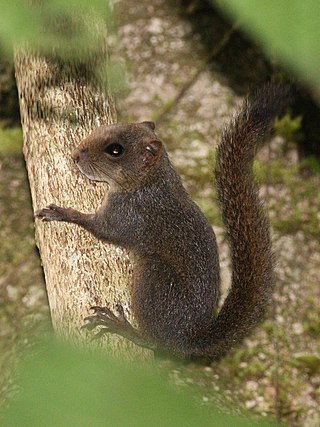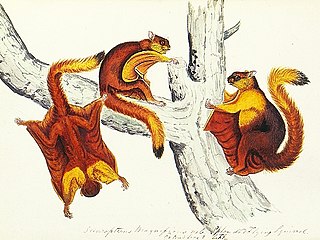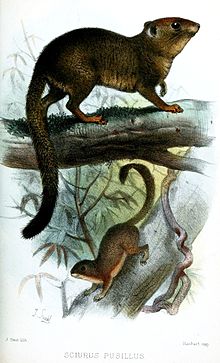
Squirrels are members of the family Sciuridae, a family that includes small or medium-sized rodents. The squirrel family includes tree squirrels, ground squirrels, and flying squirrels. Squirrels are indigenous to the Americas, Eurasia, and Africa, and were introduced by humans to Australia. The earliest known fossilized squirrels date from the Eocene epoch, and among other living rodent families, the squirrels are most closely related to the mountain beaver and dormice.

Flying squirrels are a tribe of 50 species of squirrels in the family Sciuridae. Despite their name, they are not in fact capable of full flight in the same way as birds or bats, but they are able to glide from one tree to another with the aid of a patagium, a furred skin membrane that stretches from wrist to ankle. Their long tails also provide stability as they glide. Anatomically they are very similar to other squirrels with a number of adaptations to suit their lifestyle; their limb bones are longer and their hand bones, foot bones, and distal vertebrae are shorter. Flying squirrels are able to steer and exert control over their glide path with their limbs and tail.

The hoary marmot is a species of marmot that inhabits the mountains of northwest North America. Hoary marmots live near the tree line on slopes with grasses and forbs to eat and rocky areas for cover.

The grizzled giant squirrel is a large tree squirrel in the genus Ratufa found in the highlands of the Central and Uva provinces of Sri Lanka, and in patches of riparian forest along the Kaveri River and in the hill forests of Karnataka, Tamil Nadu and Kerala states of southern India. The International Union for Conservation of Nature (IUCN) lists the species as near threatened due to habitat loss and hunting.

The southern Amazon red squirrel, is a squirrel species from South America where it inhabits forests in much of north-western South America east of the Andes. Three subspecies are currently recognised. It is a dark red colour, or a dark brown grizzled with ochre, has whitish underparts and grows to a total length of 48 to 63 cm, including a very long tail. It spends much of its time on the ground in the undergrowth and feeds largely on nuts. Little is known of its breeding habits, but it is a sociable species, several individuals often feeding together in one tree. This squirrel faces no particular threats, has a wide range and is relatively common, and the International Union for Conservation of Nature lists it as a "least-concern species".

The Bolivian squirrel is a tree squirrel that is endemic to South America. Little is known of the species, which may represent a species complex.

The Amazon dwarf squirrel is a chipmunk-sized tree squirrel native to South America.

Microsciurus or dwarf squirrels is a genus of squirrels from the tropical regions of Central and South America.

The red giant flying squirrel or common giant flying squirrel is a species of rodent in the family Sciuridae (squirrels). It is found in a wide variety of forest–types, plantations and more open habitats with scattered trees in Southeast Asia, ranging north to the Himalayas and southern and central China. One of the largest arboreal squirrels, all populations have at least some reddish-brown above and pale underparts, but otherwise there are significant geographic variations in the colours. The taxonomic position of those in the Sundaic region is generally agreed upon, but there is considerable uncertainty about the others, which variously have been included in this or other species, or recognized as their own species.
The Bolivian bamboo rat, is a species of spiny rat from South America.

Prevost's squirrel or Asian tri-coloured squirrel is a colourful species of rodent in the family Sciuridae. It is found in forests in the Thai-Malay Peninsula, Sumatra, Borneo and nearby smaller islands, with an introduced population in northern Sulawesi. Although the Prevost's squirrel is declining in some regions because of habitat loss and hunting, the species is not considered threatened since it generally remains common and widespread. It can live in somewhat disturbed habitats and often visits plantations or gardens. It mostly feeds on plant material, especially fruits, but also takes insects.

The Central American dwarf squirrel, also known as Alfaro's pygmy squirrel, is a small tree squirrel in the genus Microsciurus and tribe Sciurini found in Colombia, Costa Rica, Nicaragua, and Panama. No species of squirrel within this genus are listed as endangered, however they are rarely seen because they are extremely elusive. This suggests that their population numbers may be larger than documented.

The Santander dwarf squirrel is a small tree squirrel endemic to Colombia.

The African pygmy squirrel is a species of rodent in the family Sciuridae. It is monotypic within the genus Myosciurus. It is found in tropical rainforests in Cameroon, the Republic of the Congo, Equatorial Guinea, and Gabon. It is not considered threatened, but likely declines locally due to habitat loss. Together with the least pygmy squirrel of Asia, the African pygmy squirrel is the world's smallest squirrel measuring about 12–14 cm (4.7–5.5 in) in total length and just 15–18 g (0.53–0.63 oz) in weight, which is less than a typical house mouse.

Hodgson's giant flying squirrel is a species of rodent in the family Sciuridae. This large flying squirrel lives in Himalayan forests in Asia. Like other flying squirrels, it is nocturnal and able to glide long distances between trees by spreading out its patagium, skin between its limbs.

The Indian giant flying squirrel, also called the large brown flying squirrel or the common giant flying squirrel, is a species of rodent in the family Sciuridae. It is capable of gliding flight using a skin membrane, the patagium, stretched between front and hind legs. It is found in mainland Southeast and South Asia, and southern and central China.

The Andean squirrel is a tree squirrel endemic to Colombia where it inhabits montane rain forest and cloud forests of the Cordillera Occidental and Cordillera Central ranges of the Colombian Andes, at elevations between 2,000 and 3,300 metres. It is a small species with a body length of about 14 cm (6 in) and a similar length tail. It has soft, silky, reddish-brown fur, a darker tail and yellowish-grey underparts. It is thought to be diurnal but has been little studied, and the International Union for Conservation of Nature has rated its conservation status as being data deficient.

The Junín red squirrel is a species of squirrel from Peru and Ecuador.

The Guayaquil squirrel is a tree squirrel endemic to Ecuador and Peru. It is a robust squirrel with a head-and-body length of 18 to 32 cm and a similar length tail. The colour is variable; in Peru, a pale morph is more common, while in Ecuador, most individuals have darker grey fur on the forequarters, dull orange hindquarters. A melanistic morph is sometimes seen. It lives largely in trees and is diurnal, feeding on seeds, flowers, and other plant material, fungi and some insects. These squirrels are also found in urban areas, living in close proximity to humans, and may be vectors for leptospirosis and Chagas disease. This squirrel faces no particular threats, has a wide range and is relatively common, and the International Union for Conservation of Nature has rated it as being of "least concern".

The Cambodian striped squirrel is a species of rodent in the family Sciuridae. It is found in eastern Thailand, Cambodia, southern Laos, and southern Vietnam.




















